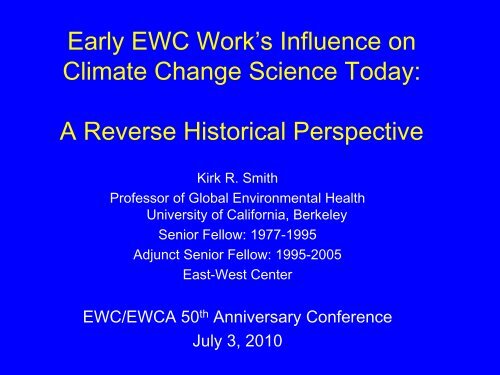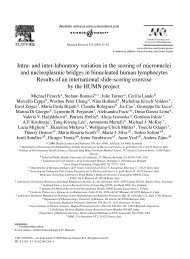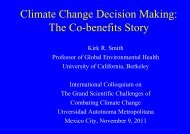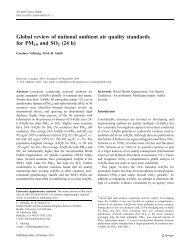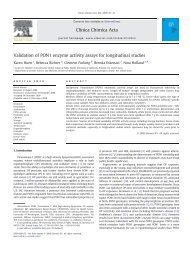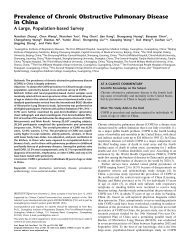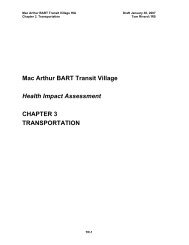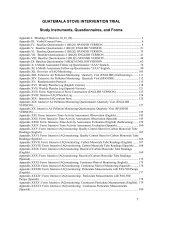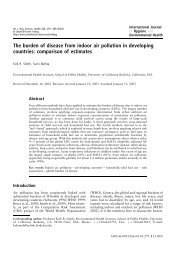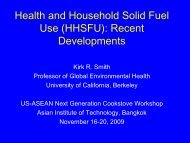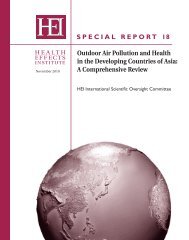Early EWC Work's Influence on Climate Change Science Today: A ...
Early EWC Work's Influence on Climate Change Science Today: A ...
Early EWC Work's Influence on Climate Change Science Today: A ...
Create successful ePaper yourself
Turn your PDF publications into a flip-book with our unique Google optimized e-Paper software.
<str<strong>on</strong>g>Early</str<strong>on</strong>g> <str<strong>on</strong>g>EWC</str<strong>on</strong>g> Work’s <str<strong>on</strong>g>Influence</str<strong>on</strong>g> <strong>on</strong><strong>Climate</strong> <strong>Change</strong> <strong>Science</strong> <strong>Today</strong>:A Reverse Historical PerspectiveKirk R. SmithProfessor of Global Envir<strong>on</strong>mental HealthUniversity of California, BerkeleySenior Fellow: 1977-1995Adjunct Senior Fellow: 1995-2005East-West Center<str<strong>on</strong>g>EWC</str<strong>on</strong>g>/<str<strong>on</strong>g>EWC</str<strong>on</strong>g>A 50 th Anniversary C<strong>on</strong>ferenceJuly 3, 2010
Stories that could be told• Natural debt: cumulative historical greenhouseemissi<strong>on</strong>s as a resp<strong>on</strong>sibility metric• Co-benefits (no-regrets, Win-Win): climatemitigati<strong>on</strong> strategies that also achieve healthprotecti<strong>on</strong> or other important goals– The importance of household fuels in climate andhealth• Exposure efficiency: Applicati<strong>on</strong> of exposurescience methods to health and climateassessment• Risk Transiti<strong>on</strong>: how envir<strong>on</strong>mental risks,including those related to climate change, shiftwith development
Cartogram of <strong>Climate</strong>-related Mortality (per milli<strong>on</strong> pop) yr. 2000This is the distributi<strong>on</strong> of impacts, but whatis the distributi<strong>on</strong> of resp<strong>on</strong>sibility for them?From malnutriti<strong>on</strong>, violent weather, heat stress, malaria, diarrhea: WHO estimates.Patz JA, Gibbs HK, Foley JA, Rogers JV, Smith KR, 2007, <strong>Climate</strong> change andglobal: Quantifying a growing ethical crisis EcoHealth 4(4): 397–405,2007
Who should pay?• Can be based <strong>on</strong> who can pay, i.e., income or wealth• Good argument that it should be based at least partly <strong>on</strong>who caused the problem – polluter pays principle• Fair to ask countries to pay today for what they emitted inthe past, even if ignorant then• Reas<strong>on</strong>: they accepted the benefits of the ec<strong>on</strong>omic activitythat produced the emissi<strong>on</strong>s in the past and thus shouldaccept the debts that were accumulated at the same time.• “Natural debt” is analogous to nati<strong>on</strong>al debt: not borrowingfinancial resources from the future, but borrowingassimilative capacity of the envir<strong>on</strong>ment• We put in greenhouse gases faster than they can renaturally removed, building up a debt
AMBIO, 19911996, J WileyUNU Press, 19931993, Still UNU in Press print – still in print
Cumulative CO 2 emissi<strong>on</strong>s from fossil fuels(as depleted by natural processes)Natural DebtPatz JA, Gibbs HK, Foley JA, Rogers JV, Smith KR, 2007, <strong>Climate</strong> change and global:Quantifying a growing ethical crisis EcoHealth 4(4): 397–405, 2007
Distributi<strong>on</strong> of Health Impacts from<strong>Climate</strong> <strong>Change</strong>(Experiencing versus Imposing)10.00DALYs per 10001.000.100.010 5000 10000 15000 20000 25000 30000 35000Income0.00PPP per capitaSmith and Rodgers
Distributi<strong>on</strong> of Health Impacts from<strong>Climate</strong> <strong>Change</strong>(Ratio: Imposing/Experiencing)Ratio10000100010010>8000x different!!Richcountriesimpose>500times morerisk thantheyreceive10.10.010 5000 10000 15000 20000 25000 30000 35000Poor countries receive >16 times more healthrisk than they imposePPP per capita
Nati<strong>on</strong>al Natural Debts:Cumulative CO 2 emissi<strong>on</strong>s, depleted by natural processesThis kind of calculati<strong>on</strong>, howeveris based <strong>on</strong>ly <strong>on</strong> CO 2 emissi<strong>on</strong>s fromfossil fuels and cement – no othergreenhouse emissi<strong>on</strong>sPatz JA, Gibbs HK, Foley JA, Rogers JV, Smith KR, 2007, <strong>Climate</strong>change and global health: Quantifying a growing ethical crisis,EcoHealth 4(4): 397–405, 2007.
How much allocatedto each living pers<strong>on</strong>from both these GHGs--- our natural debts?Warming in 2005from emissi<strong>on</strong>ssince 1750More than halfdue to methaneIPCC, 2007
Distributi<strong>on</strong> of Global Natural Debt Am<strong>on</strong>g Top 10 Nati<strong>on</strong>sCO2 <strong>on</strong>ly in 2005Nb. Land-use changeemissi<strong>on</strong>s not areparsed out by countryLUC20%USA21%CHINA8%Other26%RUSSIA6%Brazil: 0.8%FRANCE2% CANADA2% UKRAINEUK3%2% INDIA2%JAPAN4%GERMANY4%Smith and Rogers,in preparati<strong>on</strong>
Distributi<strong>on</strong> of Global Natural Debts in Top 10 Nati<strong>on</strong>sCH4 and CO2 in 2005[compared to CO2 al<strong>on</strong>e; note decrease for USA, increase for China,and large increases for India and Brazil]LUC12.9%USA17.1%CHINA10.9%Other33.2%RUSSIA6.2%INDIA5.5%CANADA1.6%UK2.1%BRAZIL2.4%GERMANY3.3%JAPAN2.6%UKRAINE2.1%Nb. Nati<strong>on</strong>al fossil fuel/cement emissi<strong>on</strong>s <strong>on</strong>ly for CO2, land-use changeemissi<strong>on</strong>s are not parsed out by countrySmith and Rogers,in preparati<strong>on</strong>
A series of six articles in The Lancet, Nov 2009C<strong>on</strong>clusi<strong>on</strong>: Projects to improve household combusti<strong>on</strong>am<strong>on</strong>g the world’s poor seem to have the largest potentialfor co-benefits globally,i.e., significantly protecting both climate and health
Energy for Sustainable Development, 2004
Global Warming by Sector - 2020Unger et al.2010
How much of what pollutants are produced?• Only <strong>on</strong>e database of systematic measurementsavailable for answering this questi<strong>on</strong>.• ~30 fuel/stove combinati<strong>on</strong>s each in India andChina• Emissi<strong>on</strong> factors for ~55 pollutants both healthandclimate‐damaging, al<strong>on</strong>g with efficiency• Developed under EPA grant to <str<strong>on</strong>g>EWC</str<strong>on</strong>g> in early 1990sand c<strong>on</strong>ducted with TERI/Delhi andTsinghua/Beijing• Published over the late 1990s – still used by IPCCand nearly all other atmospheric sciencemodelers• Only in 2010, is EPA starting to work to updatethis inventory in a systematic way
Chemosphere, 1993
Woodsmoke is natural – how can it hurt you?Or, since wood is mainly just carb<strong>on</strong>, hydrogen, and oxygen,doesn’t it just change to CO 2 and H 2 O when it is combinedwith oxygen (burned)?Reas<strong>on</strong>: the combusti<strong>on</strong> efficiency is far less than 100%
Energy flows in a well-operating traditi<strong>on</strong>alwood-fired Indian cooking stoveA Toxic Waste Factory!!Wood: 1 kg15.3 MJTraditi<strong>on</strong>al 15% moisture StoveTypical biomass cookstoves c<strong>on</strong>vert 6-20% of thefuel carb<strong>on</strong> to toxic substancesInto Pot2.8 MJ18%In PIC1.2 MJ8%Waste Heat11.3 MJ74%PIC = products of incomplete combusti<strong>on</strong> = CO, HC, C, etc.Source:Smith,et al.,2000
Indian Burden of Disease from Top 10 Risk Factorsand Selected Other Risk FactorsUnderweightUnsafe water/sanitati<strong>on</strong>-E*Indoor smoke-EUnsafe sexIr<strong>on</strong> deficiencyIndia: 420,000 deaths/yearGlobally: 1.6 milli<strong>on</strong>TobaccoBlood pressureChild cluster Vaccinati<strong>on</strong>CholesterolRoad traffic accidentsZn DeficiencyLow fruit & vegOccupati<strong>on</strong>al (5 kinds)-ELead (Pb)-EGlobal ComparativeRisk Assessment, WorldHealth Organizati<strong>on</strong>, 2004<strong>Climate</strong> change-EUrban outdoor air-EKRS from data inWorld HealthReports – 2001, 020% 2% 4% 6% 8% 10% 12% 14%Percent of All DALYs in 2000
ALRI/Pneum<strong>on</strong>iaLow birthweightAsthma?Birth defects?CognitiveImpairment?Diseases for which we haveepidemiological studies showinga link to household biomass useAlso burns and scaldsChr<strong>on</strong>icobstructivelung diseaseCataractsLung cancer(cervical,aero-digestive?)Heart disease/strokeTuberculosis?
Atmospheric Envir<strong>on</strong>ment, 1983Plenum, 1987in print for 20years
Internati<strong>on</strong>al J of Infect Disease, 1999Also <str<strong>on</strong>g>EWC</str<strong>on</strong>g> publicati<strong>on</strong>s <strong>on</strong> pneum<strong>on</strong>ia and low birthweight
Study design N* OR 95% CIInterventi<strong>on</strong> 2 1.28 1.06, 1.54Cohort 7 2.12 1.06, 4.25Case-c<strong>on</strong>trol 15 1.97 1.47, 2.64Crosssecti<strong>on</strong>al3 1.49 1.21, 1.85All 26 1.78 1.45, 2.18Dherani et al Bull WHO (2008)
Heart Disease Risk from Combusti<strong>on</strong> ParticlesAdjusted Relative Risk2.52.01.5Exposure fromSec<strong>on</strong>d hand cigarette smoke:Stars, from 2006 Surge<strong>on</strong> General Reportand INTERHEART study (Teo et al. 2006)And air polluti<strong>on</strong>:Hex, from Womens Health Initiative cohort,includes all first cardiovascular events,(Miller et al. 2007);Diam<strong>on</strong>ds, from ACS cohort(Pope et al. 1995, 2002, 2004);Triangles, Harvard Six Cities cohort(Dockery et al. 1993; Laden et al. 2006)OAPSHSHousehold AirPolluti<strong>on</strong>Exposure from smoking
First pers<strong>on</strong> in human history to have her exposuremeasured doing the oldest task in human historyHow can this simple ancient task have so much health risk?Kheda DistrictGujarat, India1981
% Households Using Solid Fuels, 2005
Perfect Storm for Health Impacts• Highly polluting activity• Half of world households• Several times a day• Just when people are present• Most vulnerable (women and youngchildren) most likely to be there
In other words, the Intake Fracti<strong>on</strong>*is extremely largeIF is the fracti<strong>on</strong> of material emittedthat is actually breathed in by some<strong>on</strong>eIF = 1.0*C<strong>on</strong>cept developed at <str<strong>on</strong>g>EWC</str<strong>on</strong>g> in mid-1980s(called exposure efficiency)
Envir<strong>on</strong>mental Management, 1986Envir<strong>on</strong>mental <strong>Science</strong>and Technology, 2002
J of Envir<strong>on</strong>mental Ec<strong>on</strong>omics and Management, 1990Climatic <strong>Change</strong>, 1990
Intake Fracti<strong>on</strong>s : these are rough calculati<strong>on</strong>s fortypical examples of sources in each classUS Coal Power PlantLDC Power PlantVehiclesNeighborhood SourcesStove Vented OutdoorsStove Vented IndoorsETSCigarette - mainstream“Rule of 1000”Something emittedindoors is about 1000times more likely toinhaled thansomething emittedoutdoors0.1 1 10 100 1000 10000 100000 1000000Smith, 1993Grams Inhaled per T<strong>on</strong> Emitted
Other implicati<strong>on</strong>s of household fuels• About <strong>on</strong>e-sixth of human-generated oz<strong>on</strong>e precursors inthe world come from household combusti<strong>on</strong>• About <strong>on</strong>e-third of human-caused carb<strong>on</strong> m<strong>on</strong>oxide• About <strong>on</strong>e-third of human-caused black carb<strong>on</strong>• A large amount of other combusti<strong>on</strong>-related particles –30-50% of total in Asia, for example• Thus, regi<strong>on</strong>al outdoor air polluti<strong>on</strong> is heavily affected byhousehold combusti<strong>on</strong> in some areas with c<strong>on</strong>sequentimpacts <strong>on</strong> health, agriculture, and ecosystems.• For example, in large Asian river basins with dense ruralpopulati<strong>on</strong>s, such as the Yangtze and Ganges.
20-m<strong>on</strong>th averageground-level PM2.5from satellite data
Household Fuels a Major SourceCross‐checking of Outdoor results: Air Polluti<strong>on</strong> in Asia%PM 2.5 from “Residential” Emissi<strong>on</strong>s from INTEX_B30%0%53%Source: Asian Emissi<strong>on</strong> Inventory for NASA INTEX_B 2006 (accessed 2010)38
All presentati<strong>on</strong>s and publicati<strong>on</strong>s available athttp://ehs.sph.berkeley.edu/krsmithOr just google “Kirk R. Smith”Thank you


